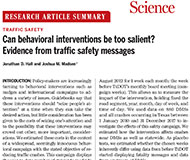5/6/2022
OPINION: Stop nagging us to deathCommentary on a recent study published in the journal Science that concluded a Texas highway sign warning about accidents actually increased accidents.

By John F. Carr
I was driving in Pennsylvania, and a sign warned me of aggressive drivers. The best defense is a good offense. I ran all those aggressive drivers off the road before they could get me.
That joke is closer to reality than we appreciate. A new study says warning people about the dangers of driving makes them more dangerous.
Texas lit up electronic signs with a count of deaths on state highways. They ran the campaign one week per month. I guess they were thinking drivers would be scared straight. In reality, accidents went up a few percent when signs were on. If the extra accidents were near the signs, we could blame drivers taking their eyes off the road. But drivers continued to have more accidents for a few minutes after passing the signs. (View the study in the journal Science)
Psychology explains. Worried and preoccupied drivers are worse drivers. When you tell people they are going to die, go to jail, lose their license or pay a fine, they start thinking about that instead of driving. And they keep thinking about it for a few minutes.
Of course, drivers can be preoccupied by other things, and non-drivers can be preoccupied too, but we have here a problem that is caused by the government and can be easily fixed by the government. Texas wants people to keep thinking about death. Being preoccupied with death, they die.
If the government is serious about safety, it will ban threats and emotional manipulation disguised as traffic messages. It will get serious about sign clutter.
Highway authorities need to ask themselves, what is a driver going to do when a particular message is displayed? A real driver, not a figment of a copywriter's imagination. Am I going to say to myself, "I had better stop crashing because some other people died"? No, I already try not to crash.
When MassDOT tells me I-95 is going to be closed for 15 minutes at an unspecified time next week, it's the same as telling me there will be a traffic jam some time next week. I already knew that. And they distracted me for five or ten seconds to tell me nothing because I have to read two or three pages of text to understand it.
Whether you tell me the fine for littering is $100 or $10,000, I still don't see any cops. And neither does the trucker with the bottle full of urine.
When Watertown, Massachusetts, decided to post fluorescent yellow signs every eighty feet, did anybody ask what drivers were expected to do? Did anybody calculate that, if drivers looked at every sign warning of pedestrians and bicycles in the road, they would they would divert about half their attention away from the road? What does "share the road" mean, anyway? That particular message is being retired because nobody knows. If you're the kind of person to brush (assault) a bicyclist or key a car, those three words aren't going to stop you.
I know other people use the road and the cops are out to get me. I don't need to be reminded. Unfortunately states are being paid to create dangerous drivers. They get about half a billion dollars per year from the National Highway Traffic Safety Administration. The three goals of a NHTSA-funded program are spend grant money, make ticket quota, and promote the latest slogans. If an electronic sign is threatening you, there's a good chance NHTSA is paying for it. Click it or ticket. Surrender or die. Surrender and die, if we believe the data out of Texas.
Hey, I just figured out how to save half a billion dollars per year of taxpayer money and a few lives -- in my dreams.
In the battle between science and slogans, slogans usually win and money always does.
John F. Carr has most recently written a four-part series on changes to federal regulations that encourage the use of speed traps:
Part 1. The introduction to this series
Part 2. Proposed changes to stop sign rules
Part 3. How speed limits are set for profit
Part 4. How to set speed limits for safety


